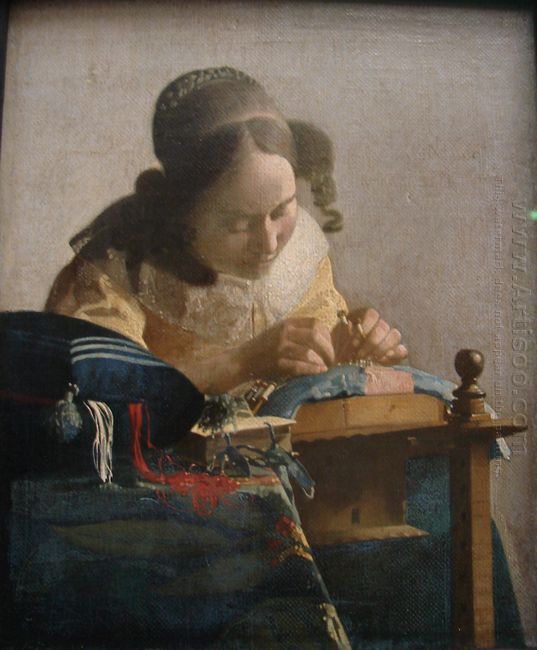The Lacemaker is the smallest genre painting by the Dutch artist Johannes (Jan) Vermeer (1632–1675), measuring roughly 9 inches by 8 inches. It was completed around 1669–1670, during the artist’s final years and resided in the Louvre Museum Paris.
The work depicts a young lady wearing a satin yellow garment with a white lace collar, head down in concentration as she hold up a pair of bobbins in her left hand and sews the threads of a dress. The lacemaker’s hairdo was said to be in vogue for a limited number of years by the costume experts. As for the lace collar, although we cannot see which kind of lace the lady is making, we can draw some conclusions from her tools which Vermeer has rendered with sufficient precision. The lady rests her hands on a flat, light-blue lacemaking pillow, which served to make shorter pieces or stripes of lace. The small parchment-covered book lying on the table is thought to be a prayer book or small Bible. Accordingly, the feather-like forms which are in front of the book are most probably book ties. It’s rendered with such artistic license that some writers regarded them as feathers. In this context, the Holy Bible definitely symbolizes domestic virtue which was a fundamental concept in Dutch civil life. The lacemaker sits at a rather complicated piece of furniture, a triangular table, for lace making. The table’s uppermost surface could be raised or lowered by inserting a peg into one of the holes in the leg. The holes can be seen in the shadowed portion of the visible leg.
The young lady is set against a blank wall to minimize the external distraction from the central image, and its colour scheme is designed to draw the viewer’s attention to the canvas, and the engagement is further encouraged (with the help of a camera obscura) by the work’s blurring foreground. Vermeer’s rendition of detail, together with his delicate handling of light and shadow in order to enhance the three-dimensional contouring of the lady’s face and hands, provides us with another class of infinite art painting.
Despite the small size of The Lacemaker, in many respects it is acknowledged as one of his most abstract and unusual created during the Dutch Baroque era. The great Impressionist painter Renoir regarded The Lacemaker as one of the two most beautiful pictures in the world. His fame is based on his complete mastery of abstract manner, the use of visual contrasts, spatial design, soft contouring and atmospheric color schemes, which make his work very different in tone and rather extraordinary. In addition, his success also owes to the ability to eternalize a pose rather than capture it, and more than anything a supreme talent for creating a moment of quiet intimacy.
